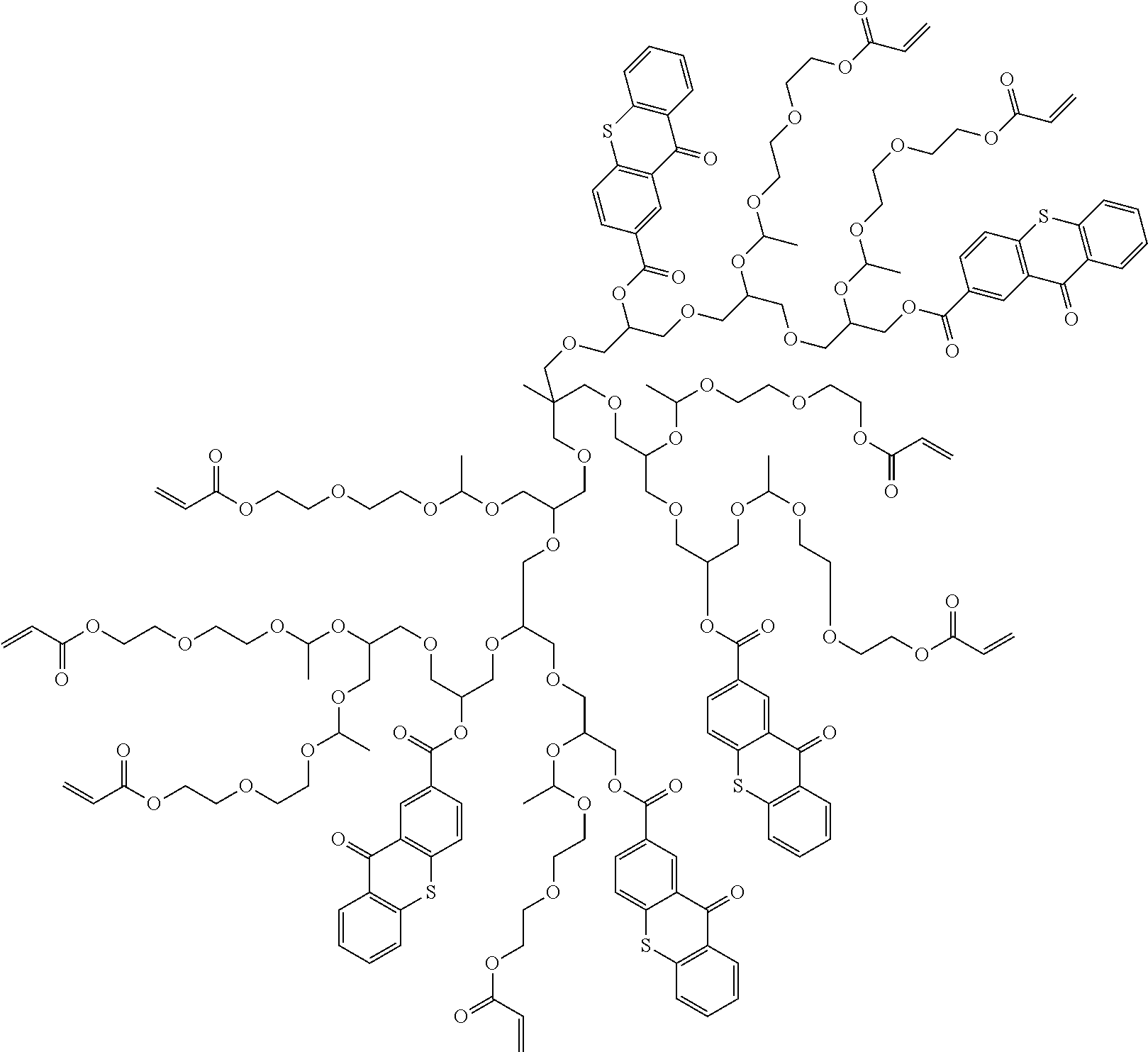Polymerizable polymeric photoinitiators and radiation curable compositions
a polymer and composition technology, applied in the field of polymer polymer photoinitiators, can solve the problems of low molecular weight, easy extraction or diffusion, and critical amount of extractable residues, and achieve the effect of simple and cost-effective synthetic procedur
- Summary
- Abstract
- Description
- Claims
- Application Information
AI Technical Summary
Benefits of technology
Problems solved by technology
Method used
Image
Examples
example 1
[0252]This example illustrates the reduced extractability of a polymer according to a preferred embodiment of the present invention.[0253]Derivatisation of a polymeric thioxanthone, the synthesis of POLY-7:
[0254]GENOPOL™ TX (supplied by Rahn A.G.) was analyzed with 1H-NMR and HPLC. It was found to be a mixture of compounds. The major components in the mixture proved to have the following structure:
[0255]
[0256]The average degree of esterification was determined using 1H-NMR. In the supplied batch, 1.5 hydroxyl groups on average were converted into a thioxanthone ester, resulting in 1.5 remaining hydroxyl groups on average. Each degree of esterification showed a distribution in degree of ethoxylation, resulting in a complex mixture of oligomers, having both hydroxyl and thioxanthone end groups.
Preparation of Pre-Formulation 1:
[0257]The polymeric initiator was further converted into a polymerizable polymeric photoinitiator, according to the following procedure, resulting in a mixture o...
example 2
[0280]This example illustrates the synthesis of the polymerizable polymeric photoinitiators POLY-8 and POLY-11
Synthesis
[0281]The polymeric photoinitiators POLY-8 and POLY-11 were prepared according to the following reaction scheme:
[0282]
Preparation of Intermediate Benzophenone Derivatized Polyglycidol
[0283]8 g of a hyperbranched polyglycidol with an average molecular weight 2000, prepared according to W02000 / 37532 (Bayer A.-G.) and Sunder A. et al, Macromolecules, 32, 4240-4246 (1999), was dissolved in 200 mL dimethyl acetamide at 40° C. 12.9 g (62 mmol) DCC was added and the mixture was stirred for 30 minutes. 13.3 g (52 mmol) 2-(4-benzoylphenoxy)-acetic acid was added and the reaction was allowed to continue for 16 hours at 60° C. The precipitated DCU was removed by filtration and the solvent was evaporated under reduced pressure. The residue was treated with 150 mL dichloromethane and the mixture was cooled to 0° C. After one hour, precipitated DCU was removed by filtration and t...
example 3
[0286]This example illustrates the advantages in curing speed and extractability of POLY-8 in a radiation curable composition.
Preparation and Evaluation of Radiation Curable Compositions
[0287]The comparative radiation curable composition COMP-6 and the inventive radiation curable compositions INV-6 was prepared according to Table 6. The weight% (wt %) was based on the total weight of the radiation curable compositions. Dibutyl phthalate was added to the radiation curable compositions as an internal reference to allow analysis of extractable residues.
[0288]
TABLE 6COMP-6INV-6COMPINI-17.5—POLY-8 in—50.0VEEAType I7.57.5COINI-17.57.5M60015.015.0VEEA60.518.0Dibutyl2.02.0phthalate
Curing Speed
[0289]The free radical curable liquids COMP-6 and INV-6 were coated on a PET100 substrate using a bar coater and a 10 μm wired bar. Each coated sample was cured using a Fusion DRSE-120 conveyer, equipped with a Fusion VPS / 1600 lamp (D-bulb), which transported the samples under the UV-lamp on a conveyer...
PUM
| Property | Measurement | Unit |
|---|---|---|
| solubility | aaaaa | aaaaa |
| viscosity | aaaaa | aaaaa |
| jetting temperature | aaaaa | aaaaa |
Abstract
Description
Claims
Application Information
 Login to View More
Login to View More - R&D
- Intellectual Property
- Life Sciences
- Materials
- Tech Scout
- Unparalleled Data Quality
- Higher Quality Content
- 60% Fewer Hallucinations
Browse by: Latest US Patents, China's latest patents, Technical Efficacy Thesaurus, Application Domain, Technology Topic, Popular Technical Reports.
© 2025 PatSnap. All rights reserved.Legal|Privacy policy|Modern Slavery Act Transparency Statement|Sitemap|About US| Contact US: help@patsnap.com



